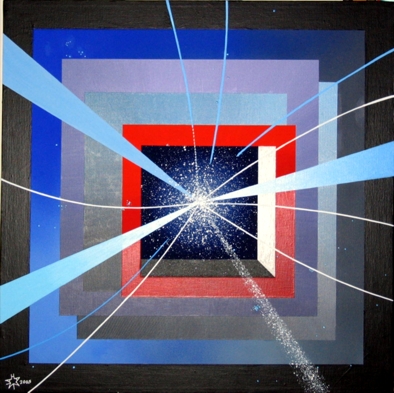My weblog ELECTRON BLUE, which concentrated on science and mathematics, ran from 2004-2008. It is no longer being updated. My current blog, which is more art-related, is here.
Fri, 02 Sep, 2005
Physics Inspired Art
When I first got into studying math and physics, just about every one of the people I talked to about it said, "You'll get artistic inspiration out of it and make new, mathematical and physics-inspired art!" Sure, I expected that I would, but that was not why I am studying math and physics. I have been doing geometric and mathematically inspired abstract art for most of my life, but only in miniature and rarely, if ever, shown in public. But now, due to some innovations in technique and materials which I talked about earlier, I'm able to make these geometric abstractions larger and turn them into real pieces that can hang on a wall.
So here's the second of my "New England" series. It's 20 inches square, acrylic on canvas, catalogue number 925. The title is UNIVERSE DETECTOR, which I will explain shortly. I had quite a number of technical difficulties with the piece, including leaky masking tape, uneven surfaces, sticky paint that wouldn't dry quickly, and tiny bugs getting onto my freshly painted surface. That's what happens when you paint in summertime. Well, now it's done and here it is.

The interlocking, more or less concentric squares in layers are inspired by the cross-section construction of the great particle detectors at accelerators like SLAC, Fermilab, and CERN. I know that these detectors are cylindrical and not square, but it's the concept that counts. In the detectors, layers of sensitive material, often huge and heavy stuff, are built up around the collision point, with the purpose of catching the tracks of the myriad particles that blast out of the colliding beams. Sometimes, interesting and unusual particle events happen, which the computers are programmed to intercept. There may be billions of collisions a second but the electronic sifters in the detector find only the ones that are unusual and worthy of study. Some of these are not just single particles, but "jets" of particles which have a distinct signature which often means that something fundamental like a quark has been smashed.
There are even some way-out theories which propose that particles created in these collisions can disappear into other universes. Sometimes a particle disappears and the physicists have no idea where it has gone. Mostly it turns out that the wayward particle escaped out a tiny gap left in the design, but other times, it just disappears. Did it go into another universe? This is why I called my painting UNIVERSE DETECTOR. You can see three distinct blue jets which means that our beams have hit a quark or some other ultimate particle dead-on. The beam collision is at the center, and the lines of blue and white denote particle trails. It's sort of like the comic book version of accelerator physics.
As an artist doing physics-inspired art, I confess that I have a major case of "physics envy." I can make any number of pictures that illustrate physics events or mathematical designs, but in doing so I am not really doing physics or mathematics. It is sort of like being a high-class fan. I can listen to the music but I can't ever play it myself. Just as I heard that my math and physics study would transform my art, I've also heard, from some of the scientists, that my art might help promote science by making it "visual" and "beautiful," and inspire young people to go into the field. Well, thanks, I think; it's still my lot to illustrate the adventure but not to have it myself. It's not like I would ever really be able to smash atoms or theorize about quarks or dark matter, since after five years I'm still working on rudimentary high school physics and math. Again, as my friendly advisers say, "You're so talented! You should do what you're best at!" Don't worry, guys, I won't stop doing art, including the geometric stuff (especially if it proves to be sell-able). But my physics envy, and my need for challenge in my life, drives me to do something I am not best at.
Posted at 3:45 am | link
